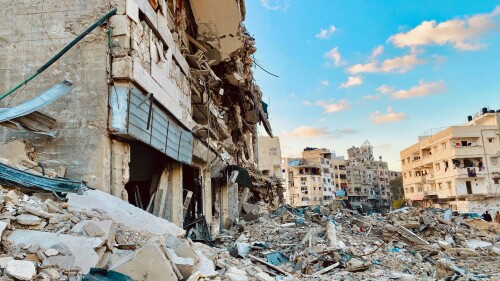The recent unrest in Suweida province in Syria has shown that the situation in the country remains far from resolved. While Syria has dropped from the headlines, the events in Suweida and beyond indicate that significant parts of the population in the regime-controlled parts of Syria are far from reconciled to the prospect of continuing to live under the rule of the Assad family. The country remains divided into areas of control, and with none of the issues that triggered the civil war in 2011 resolved.
What is the current Israeli interest in Syria, and what should Israel be seeking from allies and partners in terms of the diplomacy on Syria? Israel’s primary goal in Syria is the halting of the advance of Iranian influence and capacity in the country.
From an Israeli point of view, the current diplomatic situation in Syria – in which the regime remains isolated by the West, and without major reconstruction efforts underway from Western companies or states – is the ideal background for the continued prosecution of the Israeli military efforts against Iranian entrenchment and consolidation on Syrian soil.
The control by the US and its Kurdish allies in the Syrian Democratic Forces constitutes an incomplete but significant barrier to Iranian freedom of movement and action between Iraq and Syria.
Thus, Israel should use all available diplomatic channels to encourage the West to maintain its firm stance on Resolution 2254 and the continued isolation of the Assad regime. If Assad succeeds in ending his isolation and normalizing relations with the West, it is a near inevitability that at a certain point, US pressure on Israel would begin to induce it to cease its military campaign on Syrian soil, on the grounds that the conflict has finished, Syria is now a normal actor on the international stage, etc.
Similarly, the continued de facto partition of Syria is a clear Israeli interest. The control by the US and its Kurdish allies in the Syrian Democratic Forces constitutes an incomplete but significant barrier to Iranian freedom of movement and action between Iraq and Syria. Because of the presence of this entity, which controls around 30% of Syria’s territory, the Iranians have only one route between Iraq and Syria, namely the al-Qaim/Albukamal border crossing at Syria’s southeastern tip. In the event of war, the limited maneuverability of Iranian forces and their proxies would offer an advantage to Israel, which could swiftly disable the border crossing and the roads leading westwards from it. Thus, Israel should use its diplomatic representations and capacities to seek to induce the US and its allies to remain in Syria.
Even the Sunni Islamist, Turkish-dominated enclave in the northwest of the country offers an advantage to Israel in that its presence keeps the regime weakened, prevents it from focusing on the reconquest of the southeast and prevents the regime from extending its rule across the country and thus normalizing its situation. Thus, Israel should encourage Turkey in the direction of continued opposition to the Assad regime, and maintenance of its area of control in Syria.
At the same time, there is currently no realistic prospect for the fall of the regime or a process of political transition. Nor is there an obvious alternative to the regime. Extensive contacts and representations to the Syrian opposition are thus without purpose.
Regarding the “war between wars,” while there have certainly been achievements, the available evidence suggests that the tactics employed have been insufficient to deal with the reality of the penetration of the Syrian state by Iran, and the extent to which large parts of the machinery and organs of the Syrian regime state are now either working in close cooperation with or are under the control of the Iranians.
The preservation of the current diplomatic situation with regard to the country, and increased boldness and flexibility regarding the tactics to be adopted, are prerequisites for success.
The Iranians are closely involved in the vital drug production sector, in arms procurement, and even as recently revealed in the area of chemical weapons production, as well as in myriad other areas. To adequately develop responses, Israel must first internalize this reality.
Following this, the choice may well lie between an escalation and broadening of the target base for the air campaign, to include targets unambiguously associated with the Assad regime, or acceptance of a situation in which a large part of the Iranian project remains ‘out of bounds’ to Israel, enabling the Iranians to continue to consolidate and entrench themselves in Syria, as long as they do so while sheltering behind a regime flag of convenience.
It may also, unfortunately, be the case that Israeli air power alone will not be sufficient to address the issue of the full dimensions of Iranian ambitions in Syria. Cooperation with other forces in the country, most centrally the US and its local clients the SDF (possibly even elements within regime-controlled areas such as the clients with whom Israel worked in the pre-2018 period), will prove necessary.
So, Syria, in 2023, remains a crucial and central arena in the contest between Israel and the Iran-led regional project. A renewed focus, and probably a broadening and deepening of the scope of Israeli activity in the country, are required to adequately address this reality. The preservation of the current diplomatic situation with regard to the country, and increased boldness and flexibility regarding the tactics to be adopted, are prerequisites for success.








